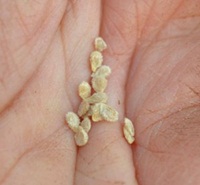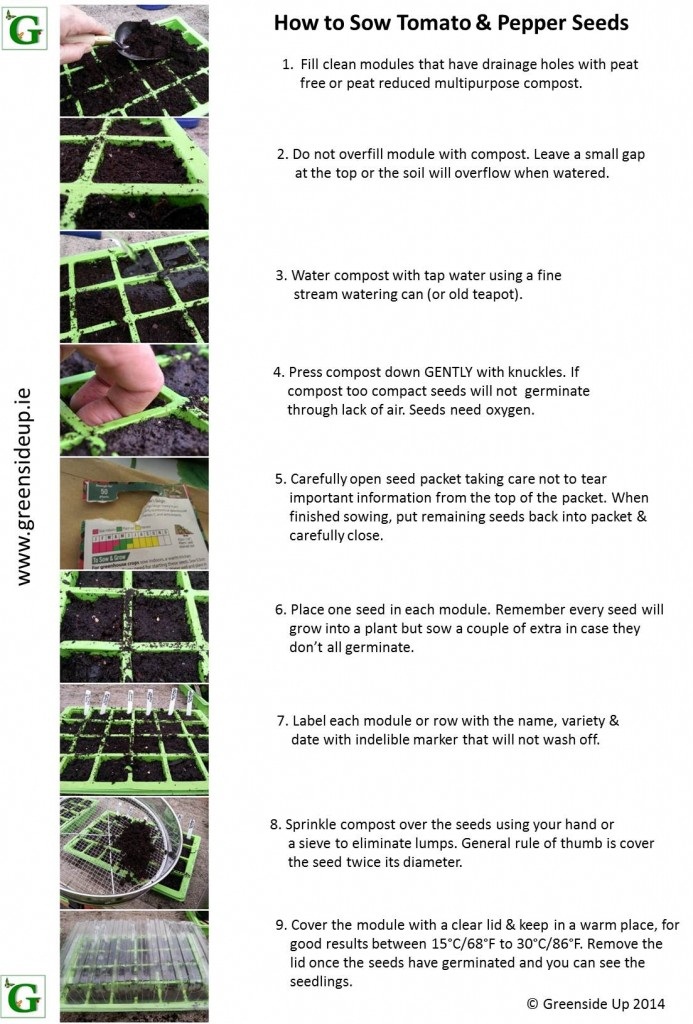![]()
Tomato and pepper seeds are some of the first that many of us will sow in the year and indeed, were the first seeds we planted in Callan Community Garden this week.

These plants need a long growing season if we are to harvest any fruit from them so February/March are often cited as the best months to sow them. However, tomato and pepper seeds need heat to germinate (between 15°C/68°F to 30°C/86°F for good results, the higher the better) so a heated mat, propagator or warm windowsill is essential for their success in Ireland.
Tomatoes and peppers are in the same vegetable family (Solanaceae) so their growing requirements are quite similar. Be very careful with your labelling if you’re sowing them at the same time as the seeds look almost identical and are very easy to mix up.
So what are you waiting for, would you like to have a go at growing your own tomatoes or peppers from seed? Here’s a step by step guide showing you how to sow the seeds.
Equipment Needed to Sow Seeds:
Seeds – Tomato / Pepper
Peat Free or Peat Reduced Compost
*A mini propagator with a lid (see image below for an idea – heated or unheated)
Watering can and an indelible marker and labels

How long will it be before I see any signs of life?
Germination, or the time it takes from sowing the seed to when you notice the first seed leaves bursting through the soil, should take less than two weeks, depending upon the temperature the seeds are grown at (the higher the temperature, the faster the germination).
Will I need to water the seeds/seedlings?
If you followed the steps above, you will have watered the compost before you sowed the seeds. It’s therefore unlikely the seeds will need any further watering whilst they’re covered as the propagator will act as a micro climate. However, after the seeds have germinated and the propagator lid has been lifted, keep an eye on the compost, ensuring its kept damp (not soaked) and that the seedlings aren’t allowed to dry out. The best way to test whether soil needs watering is to stick your finger carefully into the compost and feel how dry it is. In time you’ll learn how to recognise whether pots need watering by lifting them and feeling their weight. Watering the tray the modules are sitting in is preferable to watering the seedlings themselves as it causes less disturbance and a more equal distribution of water.
What happens next?
If you haven’t already, you might like to fill in the free email sign up form (on the side or bottom of this post, depending upon how you’re viewing it) to receive the Greenside Up blog directly into your email account. In a few weeks we’ll look at the next steps involved in growing your own tomatoes and peppers from seed and how you “prick the seedlings out and pot them on” into larger containers.
*If you’d like to try this using recycled containers, here’s a YouTube clip I made last spring showing how to sow pepper seeds.

Dee Sewell – a horticulturalist and certified trainer who started Greenside Up in 2009 and teaches people how to grow vegetables. Dee specialises in working with community gardens but also offers workshops, allotment visits, consultations, horticultural therapy, afterschools clubs as well as local talks – she tailors her services to meet clients needs. In 2012 Dee launched a Seed Gift Collection containing varieties of vegetable and insect friendly flowers with the aim of getting more people growing. Dee’s blog was a finalist in the 2012 Ireland Blog Awards in the Eco/Green and Lifestyle Categories.
Source: GreensideUp – How to Grow Tomato & Pepper Plants From Seed – Dee Sewell




